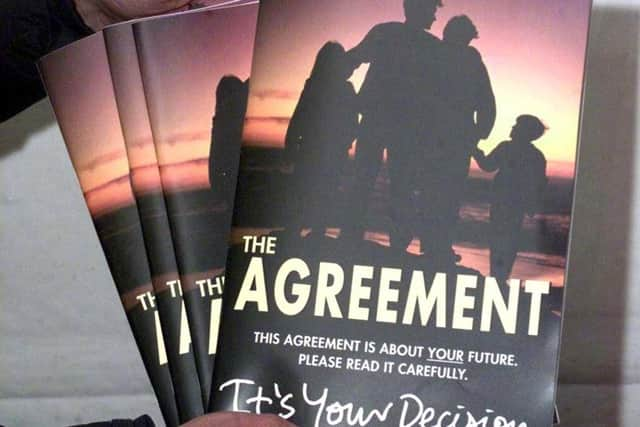Like Brooklyn Bridge, Belfast Agreement is built on sand


The construction of this bridge was not without its difficulties, particularly from the corrupt New York political machine based on patronage and graft, known as ‘Tammany Hall’.
This however was not the only difficulty the builders faced.
Advertisement
Hide AdAdvertisement
Hide AdWhile they were able to find a stable rock base to construct a tower on the Brooklyn side, at a depth of 44 feet, the Manhattan side proved more problematic. Having gone to a depth of 78 feet, they were still unable to find a solid rock foundation.


The engineers, however, calculated that the sand base at the Manhattan side was so compressed that it was stable enough to erect the tower. This proved to be correct.
Jesus told a story about two builders, it is recorded in Matthew 7:24-29. One builder built a house on a rock while the other built it on sand. The inevitable consequences followed when the storms came.
In the case of the Brooklyn Bridge, however, the sand on the Manhattan side had been compacted over many millennia, so that it was as stable as rock.
Advertisement
Hide AdAdvertisement
Hide AdI reflected on the present political climate in the light of these two stories.


As we pass the twentieth anniversary of the Belfast Agreement, it may be useful to look at both these stories together.
It could be said of the Belfast Agreement of 1998 that, it was built on sand, very unstable foundations, even though 71.1% of people supported its construction.
Unstable foundations can be stabilised given time and circumstances, as in the case of the Brooklyn tower on the Manhattan side.
Advertisement
Hide AdAdvertisement
Hide AdJust as trees are often planted in unstable conditions and, as the roots develop, they prove to be a unifying and stable force. In the case of the Brooklyn Bridge the compressed sand has proven to be a solid foundation.


The Belfast Agreement was built of the sand of ‘constructive ambiguity’ and was not given the time to ‘bed down’ and become the solid base on which to continue the construction. It was subject to storms from its very inception.
There was the unwillingness of Sinn Fein/ IRA to comply with the ‘exclusively peaceful means’ which Senator Mitchell enshrined as a principle. Mo Mowlam’s ‘housekeeping murders’, the unwillingness of the IRA to transparently decommission its weapons, the Northern Bank robbery of December 2004, the murder of Robert McCartney and others incidents have all eroded the confidence so clearly expressed in the summer of 1998.
The comments of Kenneth Bloomfield are worth noting: “Sinn Fein would claim that it never breached the wording of the agreement, but its dishonouring of its spirit left Trimble out to dry”.
Advertisement
Hide AdAdvertisement
Hide Ad71.1% of people voted for a future rather than a past, but that future has been elusive, largely because it lacked a spirit of generosity.


The former Secretary of Sate, Owen Paterson, is right to affirm that it has ‘outlived its use’. The experiment of the Belfast Agreement has failed — not because of the substance of the agreement itself, but because of the failure of those involved in its political outworking.
What was envisioned was that, in the case of the IRA, they would become an Old Boy’s Club, meeting as a purely social group in the Felons Club, but not influencing future generations.
Those who voted in favour of the agreement expected it to be kept in spirit as well as letter. I can well recall Martin McGuinness, on a visit to his old school St Eugene’s, the day after his appointment as Minister of Education on 30 November 1999.
Advertisement
Hide AdAdvertisement
Hide AdHe commented as the pupils prepared to go on a trip to Donegal, that the last time he was in that area he was ‘on the run’. This comment, at such an early stage in the ‘Peace Process’, was not the kind of comment to instil confidence in the future.
While everyone has the right to remember their dead, those who supported the agreement did not think, for one moment, that Sinn Fein would ‘keep the pot boiling’ with their constant glorification of the terrorist past.
Had they realised that, then the agreement may not have had such overwhelming support.
Had the agreement been given time, and had the sandy foundation been allowed to compact, it may well have become a firm foundation, but this was not to be.
Advertisement
Hide AdAdvertisement
Hide AdThe Belfast Agreement may well be an international agreement lodged with the United Nations, but the fact remains that it has not been implemented in spirit or in practice.
This erosion of confidence has led to the destruction of the ‘middle ground’ with both the Ulster Unionist Party and the SDLP suffering virtual annihilation over subsequent elections.
Ironically we are left now with two opposing ideologies to implement the agreement.
One ideology republican, which never enthusiastically embraced the agreement, and the other the DUP, who opposed it.
Is it any wonder the fragile foundations have been undermined?
• Rev Brian Kennaway is author of ‘The Orange Order: A Tradition Betrayed’